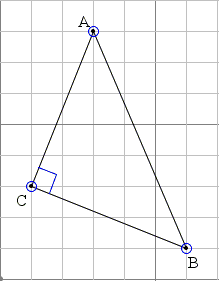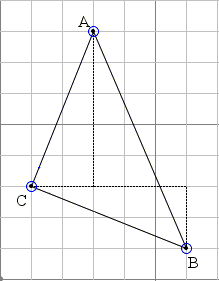Hunting Right Angles
Have you tried to form a right triangle with vertices on a square grid? It is easy of course to find Pythagorean triangles with horizontal and vertical legs. Can you find less trivial configurations? The applet below is intended to assist you with this task.
|
If you want to approach the task of finding right triangles systematically, start with forming isosceles ones. There is a multitude of isosceles right triangles, e.g.,

|
Choose a point - C in the example - and a vector

|
Leg BC, in this case, passes through one additional grid point. (You may try your hand in finding grid right triangles with the help of the applet.)
An examination of the right triangles on a square grid leads to some trigonometric identities. For example, observe that, by construction, the right angle below is the sum of two angles, one with the tangent equal to 2/5 and the other 5/2:

|
Thus we may conclude that arctan(2/5) + arctan(5/2) = 90°. (arctan is the inverse of the tangent. If
| arctan(a) + arctan(1/a) = 90°, |
for any a. Additional trigonometric identities emerge from considering the acute angles. In the example above, angle
| arctan(2/5) + arctan(3/7) = 45° (= arctan(1).) |
Another curious identity arctan(1/2) + arctan(1/3) = arctan(1) is illustrated by the diagram below

|
Here are further examples where, as before, we focus on the angle at A. The idea is that the triangles are constructed by extending one of the legs of a right isosceles triangle.

|
Leg AC was extend by the factor of 2, leading to arcttan(1/3) + arctan(1/7) = arctan(1/2), | ||

|
Leg BC was extended by the factor of 4, leading to arctan(2) + arctan(2/9) = arctan(4), | ||

|
Leg BC was extended also by the factor of 4, leading to arctan(3) + arctan(1/13) = arctan(4). |
In the latter one, looking at the angles at vertex B, leads to a modification:
| arctan(1/4) + arctan(1/13) = arctan(1/3). |
The number of such identities that, at first sight, might appear surprising is endless. Here is another one:
